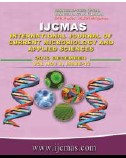


 National Academy of Agricultural Sciences (NAAS)
National Academy of Agricultural Sciences (NAAS)

|
PRINT ISSN : 2319-7692
Online ISSN : 2319-7706 Issues : 12 per year Publisher : Excellent Publishers Email : editorijcmas@gmail.com / submit@ijcmas.com Editor-in-chief: Dr.M.Prakash Index Copernicus ICV 2018: 95.39 NAAS RATING 2020: 5.38 |
An experiment was conducted in February (2018) to know the effect of different methods of substrate treatment (carbendazim + formaldehyde, hot water, lime 2% and plane water) on spawn run, pin head initiation and yield of Pleurotus spp. on wheat straw substrate. The results are clearly indicates that on an average time for spawn run period was significantly quickest (7.25 days) noticed in species PL-17-12, while PL-17-07 took more (14.25 days) time for spawn run. Among the evaluated different methods of substrate treatment, the average period recorded for spawn run was statistically differed and it was significantly less (9.94 days) recorded in carbendazim + formaldehyde followed by hot water and lime 2% (10 days) and which were at par with each other. While more (11.80 days) period taken by plane water. Interaction of species × substrate treatment method also showed significant difference for spawn run period of Pleurotus species. PL-17-12 required minimum (7 days) period for spawn run with carbendazim + formaldehyde, hot water and lime 2% than other combination and maximum (16.33 days) period taken by PL-17-07 with plane water. The average days for pinhead initiation in different species of Pleurotus, recorded earlier (2.91 days) pinhead initiation was recorded in species PL-17-11 and it was significantly delayed (8.25 days), in PL-17-10. In different method of substrate treatment, faster pinhead initiation was found in hot water treated substrate (4.55 days) while it was took maximum (5.36 days) time in carbendazim + formaldehyde. On an interaction, pinhead initiation was quickest (2.33 days) found in species PL-17-12 with hot water treatment than other combination and more (9.33 days) period taken by carbendazim + formaldehyde and plane water in PL-17-07. The average yield of different species with substrate treatment varied significant with each other. The significantly higher (532.91 gm) yield was recorded in species PL-17-11 while PL-17-10 gave significant lower yield (159.56 gm). On different substrate treatment maximum yield (398.75 gm) was recorded in hot water treatment method and minimum yield (174.44 gm) was found in plane water. Interaction of species × substrate treatment method also showed significant differences in yield. The highest yield was recorded in species PL-17-11 (615.0 gm) with BE 123% in carbendazim + formaldehyde followed by hot water (595.0 gm) with BE 119% and lime 2% (591.0 gm) with BE 118.2% and they were statistically at par with each other, whereas, plane water gave minimum yield (48.33 gm) with BE 9.6% in species PL-17-10.
 |
 |
 |
 |
 |